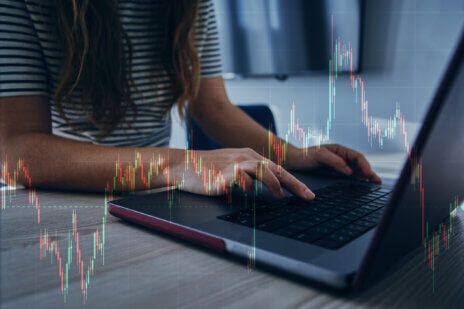
Thornburg client portfolio managers discuss how active management can help investors identify sector opportunities and navigate current economic conditions.
Active Management, International Investing, and Dividends
Josh Rubin: This is the CPM roundtable, where Thornburg client portfolio managers will discuss topics that are top of mind for investors. My name is Josh Rubin, and I’m joined today by Phil Gronniger and Adam Sparkman. As client portfolio managers, we’re engaged daily with both the investment team and clients, which gives us a unique insight to what’s top of mind. So far, we’ve discussed US/China relations, corporate earnings and tariffs. Today, we’re going to shift to how active management can shine when trying to navigate this environment, and some of the different sectors that investors might consider.
Adam, one of the benefits of, the client portfolio manager seat is we see both what the investment team is thinking, along with what clients are thinking about. Given volatility in the news cycle and how that raises concerns for clients and prospects, along with how the investment team behaves about that, do you think there’s a different opportunity for active management, whether in the execution of implementing portfolios or just in the way that we message in this current environment, compared to maybe how we were messaging in the past?
Adam Sparkman: I do I think in periods of elevated volatility is really when active management can, can really earn its stripes. Going into this new presidency, really thinking back to late summer or early fall here at Thornburg is really when a lot of our portfolio managers started thinking about the potential impacts of tariffs and making sure that we weren’t in companies that were really prone to be, victims of macroeconomic forces outside of their control.
So, within a lot of our portfolios, we were able to, bias away from some of the things that we have seen in the news, things that, have been, in the crosshairs of tariffs. I think that’s been a, a big benefit for our portfolios. You know, we’re not trying to construct anything, make macro calls on how to position, but we have, a lot of flexibility in, looking inside markets and, and really finding who we think the best bottom-up opportunities are.
Josh Rubin: It’s interesting. One thing that made me think about is if you think about typical economic cycles, you know, GDP growth might swing 2 to 5% up or down and corporate earnings might swing 10 or 15%, but then stocks suddenly are swinging 25 or 30% when it’s risk on or risk off. And corporates, the way they operate, they’re aware of macro data, they’re aware of, you know, government policy. But really, they’re in the trenches every day, just selling XYZ widget, making XYZ loan. And so, in a lot of ways corporates that can adapt to, you know, the macro environments more slowly adapting than the traffic in the store every day. And so, corporates who really are aware and willing to make adjustments in this environment, they don’t need the macro data to make their decisions. They see what’s going on the ground. And that’s that is part of what active managers can count on is not just a rising tide lifts all boats, but which corporate management teams actually have the proven capabilities to adjust in real time rather than waiting for, you know, labor numbers coming out six weeks after the fact or something.
Phil Gronniger: That’s particularly important when it comes to delivering for clients when it comes to active management and concentrated portfolios on the equity side. Simply buying an index through a passive ETF, gets you that nice, call it market exposure. But to really, as you, as you say, earn the stripes and really, deliver that benefit for a clientele, and doing that fundamental research, sitting down and meeting with those management teams is our analysts and portfolio managers do, traveling the world to uncover those opportunities where, the team might not just be sitting back waiting for some macro data, at a large shop to guide that decision.
It’s boots on the ground, talking to CEOs, treasurers, attending industry conferences to help gauge and find those companies that can pivot quickly when they see changes in consumer behavior or changes in, if you will, the demand for the products that they have.
Josh Rubin: Phil, let me change the subject a little bit and get your thoughts on this. When we think about passive, that really is a flows driven market. You know, the nature of passive participation. We know in the U.S. there’s $7 trillion of cash sitting on the on the sidelines. When you put that against GDP, it’s basically the second highest level it’s been in in 30 or 40 years. That cash is you think about where it might be deployed, fixed income markets, equity markets, we also know flows into U.S. equities have been far stronger than flows into international equities. But do you see ways either that active managers, should be thinking about the possibility of cash coming off the sidelines, whether fixed income or equities or, you know, active managers shouldn’t worry about the cash coming off the sidelines because they’re making decisions based on other things.
Phil Gronniger: Yeah, I think as an active manager, I think it’s a fantastic opportunity to one show you that you’re delivering for clients to attract some of that capital, whether it’s on the equity or the fixed income side. And from what we’ve heard in their client portfolio, managers seat and traveling and meeting with clients is that many of them are feeling perhaps like they missed an opportunity on the equity side, or they’re comfortable sitting in cash, earning a decent amount that they couldn’t get the last 15 years until rates rose in 2022. So, what we’re hearing and having discussions about is one, bringing that underweight back to a neutral on the non-U.S. exposure, global or international.
And we’re seeing some of that activity happening already. And the active management side or two on the fixed income side. With that said, on the precipice of cutting rates more, starting to see those money market rates or yields go down. So, offering the opportunity to maintain a better income level, better yield on the fixed income side. So, starting to hear that desire to put the money to work where they might just be sitting in cash, earning the money market right now.
Adam Sparkman: Yeah. And I think particularly on the equity side and the non-U.S. equity side, you know, in conversations, I think all three of us have had, you know, advisors will ask if they’ve potentially missed the rally, kind of given the strong performance we’ve seen out of some of these non-U.S. markets. And if it’s too late, put some of this money to work or rotate a bit more to international, where a lot of his advisors have been underweight.
And while I’m hesitant to make overarching predictions on the short term, I do think a couple points that are pretty interesting when you look at the overall, dynamics of non-international versus the U.S, we have a chart that shows, forward P/E historically of the MSCI, MSCI ACWI Ex-U.S. versus the S&P 500. And what you see is today, even after a bit of a rally in non-US, the ACWI Ex-U.S is still trading at roughly a 35% discount to the S&P 500.
If you look back over the past 20 or so years, that’s one of the largest discounts that we’ve seen between those two markets. And it’s only slightly less than the spread that we saw coming into the year. So I do think that if you look at the fundamentals, there’s still an opportunity to take advantage of, potential mispricing or just opportunity, in these markets.
And then, Josh, I think about a chart that you actually put together last week as well, which highlights that the U.S is pretty expensive right now. I think we’re, you know, potentially hitting all time highs, this week even. But when you look at valuations on a forward basis and you see the S&P trading at 22 times, if you look at historically kind of five years out on a forward return basis, you know what you get when you you’re investing in the starting point.
Typically it’s been negative to kind of low single digit returns. So, understanding that the last 10 or 15 years, the returns that we’ve seen out of the US, you know, maybe may not be set up in the same way and diversifying a little of that risk into cheaper international markets, where you maybe are investing in a better starting base.
Josh Rubin: Adam, what you’re talking about, we’ve talked in this conversation a lot more about sort of the macro and top down, but maybe something that people aren’t talking about as much is just bottom-up earnings growth. And you know, what we’ve seen year to date has been generally downward revisions in U.S earnings. In local currency terms. We’ve seen sort of stable earnings just slightly up earnings expectations for international stocks.
But then we have been continuing to see the weakening of the US dollar. And what we’ve even seen with the US dollar is when it’s announced major trade agreements with Korea or Japan, the dollar’s not strengthening. When we announced it with Europe, the dollar didn’t strengthen. When the jobs numbers, came out weaker than expected, the dollar did not strengthen. You know, it’s been weakening a little bit. And so, we sort of seem to be seeing stable and perfectly solid international earnings. But then combined with a strengthening international currency basket. And so for us investors, if you get a currency tailwind, you know, that feels kind of stable. And secondly, if you just have solid earnings, that’s a pretty positive thing given the starting point in valuations.
That’s kind of been the biggest challenge for the last decade has been international had low valuations, but it hasn’t had the earnings growth. And now a starting point of low valuations with equal or maybe even better, but certainly similar earnings growth, that’s a much more attractive starting point, especially compounded with a few extra -percentage points of dividend yield on top of that too.
Adam, if we’re in that sort of environment where maybe economic activity is not meaningfully declining, but there’s uncertainty from the equity side, you know, can companies afford dividend payouts or are dividends attractive relative to bonds? You know, or is everything equalized?
Adam Sparkman: Yeah, I actually think that’s, a really good set up for more dividend-oriented companies. We do have that, long end of the curve still up. We still have, you know, the possibility of a little bit of an inflationary environment. I think companies that are able to pay an attractive yield today to their clients, in the form of dividends and, can benefit as, and in more of a stable rate environment. I think that could be an attractive setup for those sort of companies.
Josh Rubin: Adam, Phil, on one hand it’s been a slow summer, but there’s always something happening. Thanks for the conversation today and we’ll continue and pick up on these topics again soon.
Important Information
The views expressed are subject to change and do not necessarily reflect the views of Thornburg Investment Management, Inc. This document is for informational purposes only and does not constitute a recommendation or investment advice and is not intended to predict the performance of any investment or market. It should not be construed as advice as to the investing in or the buying or selling of securities, or as an activity in furtherance of a trade in securities.
This is not a solicitation or offer for any product or service or an offer or solicitation for the purchase or sale of any financial instrument, product or service sponsored by Thornburg or its affiliates. Nor is it a complete analysis of every material fact concerning any market, industry, or investment. Data has been obtained from sources considered reliable, but Thornburg makes no representations as to the completeness or accuracy of such information and has no obligation to provide updates or changes. Thornburg does not accept any responsibility and cannot be held liable for any person’s use of or reliance on the information and opinions contained herein. The views expressed herein may change at any time after the date of this publication. There is no guarantee that any projection, forecast or opinion in this material will be realized.
Investments carry risks, including possible loss of principal.
More Insights

FOMC Update: Fed Approves Third Consecutive Rate Cut, Projects Slower Pace

Luxury Brands Navigate China Slowdown and Tariff Pressures

Thornburg Investment Income Builder Fund – 4th Quarter Update 2025

Extract Maximum Income Using Active Management

Investment Perspectives from the Road: European Luxury Goods



